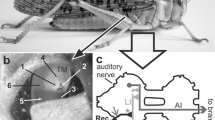Abstract
During stridulation in the gomphocerine grasshopper Omocestus viridulus the leg movements, sound pattern and either summed auditory nerve activity or single interneuron activity were recorded. Simultaneous laser interferometric and vibrometric measurements of the displacement and velocity of the tympanic membrane were performed at the pyriform vesicle (d-receptor group). Slow displacements of the tympanic membrane occur in phase with the ventilatory and stridulatory rhythm and reach 10 μmpeak-peak and 1–3 μmpeak-peak in amplitude, respectively. Additionally, the tympanic membrane oscillates maximally in the range 5–10 kHz. These high-frequency oscillations are due to sound production and motor activity and correspond in amplitude to oscillations evoked by sound pressures of 90-dB SPL. They activate the auditory receptors during most of the stridulatory cycle even during mute stridulation. Only at the lower reversal point of the leg movement are membrane vibrations and receptor activity at a minimum. As a consequence the response of receptors and interneurons to auditory stimuli are generally impaired and an auditory response of receptors and interneurons can be elicited only during a short period at the lower reversal point. Although in this phase of the stridulatory cycle auditory sensitivity is present, males do not show phonotactic responses towards female songs during ongoing own stridulation.
Similar content being viewed by others
References
Elsner N (1974) Neuroethology of sound production in gomphocerine grasshoppers (Orthoptera: Acrididae). I. Song patterns and stridulatory movements. J Comp Physiol 88:67–102
Faber A (1953) Laut- und Gebärdensprache bei Insekten: Orthoptera (Geradflügler) Teil 1. Mitt Mus Naturkd Stuttgart 287:1–198
Gray EG (1960) The fine structure of the insect ear. Phil Trans R Soc Lond Ser B 243:75–94
Hedwig B (1986a) On the role in stridulation of plurisegmental interneurons of the acridid grasshopper Omocestus viridulus L. I. Anatomy and physiology of descending cephalothoracic interneurons. J Comp Physiol A 158:413–427
Hedwig B (1986b) On the role in stridulation of plurisegmental interneurons of the acridid grasshopper Omocestus viridulus L. II. Anatomy and physiology of ascending and T-shaped interneurons. J Comp Physiol A 158:429–444
Hedwig B (1988) Activation and modulation of auditory receptors in Locusta migratoria by respiratory movements. J Comp Physiol A 162:237–246
Hedwig B (1989) Modulation of auditory information processing in tethered flying locusts. J Comp Physiol A 164:409–422
Hedwig B (1990) Modulation of auditory responsiveness in stridulating grasshoppers. J Comp Physiol A 167:847–856
Hedwig B, Knepper M (1992) NEUROLAB, a comprehensive program for the analysis of neurophysiological and behavioural data. J Neurosci Methods 45:135–148
Hedwig B, Lang F, Elsner N (1988) The interference of sound and movement stimuli in tympanal receptors of Locusta migratoria. J Comp Physiol A 163:243–252
Hedwig B, Lang F, Elsner N (1990) Modulation of auditory information processing by motor activity and mechanical stimulation in grasshoppers and locusts. In: Gribakin FG et al. (eds) Sensory systems and communication in arthropods. Birkhäuser, Basel Berlin pp 193–197
Helversen O von, Elsner N (1977) The stridulatory movements of grasshoppers recorded with an opto-electronic device. J Comp Physiol 122:53–64
Jacobs W (1953) Verhaltensbiologische Studien an Feldheuschrecken. Beiheft l, Z Tierpsychol. Parey, Berlin Hamburg
Lang F, Elsner N (1989) The interference of sound and movement stimuli in auditory interneurons of Locusta migratoria L. J Comp Physiol A 164:697–706
Meier T, Wolf H, Heiversen O von (1987) “Auditory window” for responsiveness during stridulation of grasshoppers recorded from one of their auditory interneurons. In: Elsner N, Creutzfeld O (eds) New frontiers in brain research. Proc 15th Göttingen Neurobiol Conf. Thieme, Stuttgart New York, p 85
Meyer J (1992) Biophysikalische und elektrophysiologische Untersuchungen am Tympanalorgan larvaler und adulter Feldheuschrecken (Chorthippus biguttulus L.). Diplomarbeit Universität Göttingen
Meyer J, Elsner N, Hedwig B (1992) The influence of respiration on the perception of acoustic stimuli. In: Elsner N, Richter DW (eds) Rhythmogenesis in neurons and networks. Proc 20th Göttingen Neurobiol Conf. Thieme, Stuttgart New York, p 196
Michelsen A (1971a) The physiology of the locust ear. I. Frequency sensitivity of single cells in the isolated ear. J Comp Physiol 71:49–62
Michelsen A (1971b) The physiology of the locust ear. III. Acoustical properties of the intact ear. J Comp Physiol 71:102–128
Michelsen A, Hedwig B, Elsner N (1990) Biophysical and neurophysiological effects of respiration on sound reception in the migratory locust Locusta migratoria. In: Gribakin FG et al. (eds) Sensory systems and communication in arthropods. Birkhäuser, Basel Berlin, pp 199–203
Riede K (1987) A comparative study of mating behaviour in some neotropical grasshoppers (Acridoidea). Ethology 76:265–296
Römer H, Marquart V (1984) Morphology and physiology of auditory interneurons in the metathoracic ganglion of the locust. J Comp Physiol A 155:249–262
Selbach H, Lewin A (1988) Laser-Interferometrie zur Positionsund Schwingungsmessung. Feinwerktechnik und Meßtechnik 96:1–2
Völker A (1991) Laservibrometrische und elektrophysiologische Untersuchungen des Hörvermögens der Wanderheuschrecke während der Atmung. Diplomarbeit Universität Göttingen
Author information
Authors and Affiliations
Rights and permissions
About this article
Cite this article
Hedwig, B., Meyer, J. Auditory information processing in stridulating grasshoppers: tympanic membrane vibrations and neurophysiology. J Comp Physiol A 174, 121–131 (1994). https://doi.org/10.1007/BF00192013
Accepted:
Issue Date:
DOI: https://doi.org/10.1007/BF00192013




